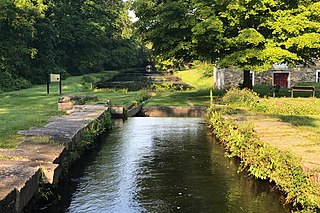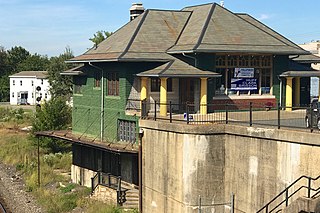
The Chesapeake and Ohio Canal, abbreviated as the C&O Canal and occasionally called the "Grand Old Ditch," operated from 1831 until 1924 along the Potomac River between Washington, D.C., and Cumberland, Maryland. It replaced the Potomac Canal, which shut down completely in 1828, and could operate during months in which the water level was too low for the former canal. The canal's principal cargo was coal from the Allegheny Mountains.

The Delaware and Raritan Canal is a canal in central New Jersey, United States, built in the 1830s, that served to connect the Delaware River to the Raritan River. It was an efficient and reliable means of transportation of freight between Philadelphia and New York City, especially coal from the anthracite fields in eastern Pennsylvania, during much of the 19th and early 20th centuries. The canal allowed shippers to cut many miles off the existing route from the Pennsylvania coal fields, down the Delaware, around Cape May, and up along the Atlantic Ocean coast to New York City.

The Morris Canal (1829–1924) was a 107-mile (172 km) common carrier anthracite coal canal across northern New Jersey in the United States that connected the two industrial canals at Easton, Pennsylvania, across the Delaware River from its western terminus at Phillipsburg, New Jersey, to New York Harbor and New York City via its eastern terminals in Newark and on the Hudson River in Jersey City. The canal was sometimes called the Morris and Essex Canal, in error, due to confusion with the nearby and unrelated Morris and Essex Railroad.

The Allegheny Portage Railroad was the first railroad constructed through the Allegheny Mountains in central Pennsylvania, United States; it operated from 1834 to 1854 as the first transportation infrastructure through the gaps of the Allegheny that connected the midwest to the eastern seaboard across the barrier range of the Allegheny Front. Approximately 36 miles (58 km) long overall, both ends connected to the Pennsylvania Canal, and the system was primarily used as a portage railway, hauling river boats and barges over the divide between the Ohio and the Susquehanna Rivers. Today, the remains of the railroad are preserved within the Allegheny Portage Railroad National Historic Site operated by the National Park Service.

Waterloo Village is a restored 19th-century canal town in Byram Township, Sussex County in northwestern New Jersey, United States. The community was approximately the half-way point in the roughly 102 miles (164 km) trip along the Morris Canal, which ran from Jersey City to Phillipsburg, New Jersey,. Waterloo possessed all the accommodations necessary to service the needs of a canal operation, including an inn, a general store, a church, a blacksmith shop, and a watermill. For canal workers, Waterloo's geographic location would have been conducive to being an overnight stopover point on the two-day trip between Phillipsburg and Jersey City.

Hopatcong State Park is a state park in the Landing section of Roxbury Township, New Jersey. Operated and maintained by the New Jersey Division of Parks and Forestry, the park consists of two parcels of land: one that encompasses Lake Hopatcong and some of its southwestern shore, and another that encompasses Lake Musconetcong about one mile to the west-southwest.

Landing Lane Bridge is part of County Route 609 and spans the Raritan River and the Delaware and Raritan Canal in New Jersey. The two lane bridge connects Piscataway to the north with New Brunswick to the south. The approaching roadways on both sides are known as "Landing Lane." The Delaware and Raritan Canal State Park and towpath is accessible from the bridge.

The Lembeck and Betz Eagle Brewing Company was founded in 1869 by Henry B. Lembeck and John F. Betz in Jersey City, in Hudson County, New Jersey, United States. The brewery, bounded by 9th, 10th, Grove, and Henderson streets in downtown Jersey City, developed into one of the most famous, best-equipped, and financially successful breweries on the East Coast of the United States.

The Inclined Plane Bridge is a 237-foot (72 m), Pennsylvania through truss bridge that spans Stonycreek River in Johnstown, Cambria County, in the U.S. state of Pennsylvania. It connects the city to the lower station of the Johnstown Inclined Plane. The bridge was listed on the National Register of Historic Places in 1988 and was documented by the Historic American Engineering Record (HAER) in 1997.

The Dundee Canal was an industrial canal in Clifton and Passaic in Passaic County, New Jersey. It was built between 1858 and 1861 and ran parallel to the Passaic River. It supplied hydropower and water for manufacturing. There was interest by some members of the business community to modify the canal to support navigational uses, but the canal was never used for that purpose.
A waste weir on a navigable canal is a slatted gate on each canal level or pound, to remove excess water and to drain the canal for repairs or for the winter shutdown. This differs for a dam or reservoir, for which a waste weir is another name for a spillway, i.e. not having the boards to adjust the water height nor the paddles to drain all the water as on a canal, only to drain the excess.

Phillipsburg Union Station is an inactive railroad station in Phillipsburg, New Jersey, United States, at 178 South Main Street. Opened in 1914, Union Station was built by the Delaware, Lackawanna & Western Railroad (DL&W) and shared with the Central Railroad of New Jersey (CNJ) and was situated where the lines merged before the bridge crossing the Delaware River. Designed by Frank J. Nies, the architect who produced many of DL&W stations now listed state and federal registers of historic places, the 2 1/2 story, 3 bay brick building is unusual example of a union station and a representation of early 20th century Prairie style architecture. The Phillipsburg Union Signal Tower, or PU Tower, is nearby.

The Raritan River Bridge is a rail bridge over the Raritan River, in New Brunswick and Highland Park in Middlesex County, New Jersey, U.S. The arch bridge carries the Northeast Corridor (NEC) at MP 30.92. It used by Amtrak, including Northeast Regional service, and New Jersey Transit's Northeast Corridor Line. It also crosses over New Jersey Route 18 and the East Coast Greenway.

The New Hampton Pony Pratt Truss Bridge is a historic pony Pratt truss bridge on Shoddy Mill Road in New Hampton of Lebanon Township, Hunterdon County, New Jersey. It crosses the Musconetcong River between Lebanon Township, Hunterdon County and Washington Township, Warren County. It was designed by Francis C. Lowthorp and built in 1868 by William Cowin of Lambertville, New Jersey. The bridge was added to the National Register of Historic Places on July 26, 1977 for its significance in engineering, industry and transportation. It is one of the few early examples of iron Pratt truss bridges remaining in the United States. It was later documented by the Historic American Engineering Record in 1991. It was added as a contributing property to the New Hampton Historic District on April 6, 1998.

The Port Murray Historic District is a historic district in the Port Murray section of Mansfield Township, Warren County, New Jersey. It was an important transportation location, being on the Morris Canal and the Morris and Essex Railroad. The district was added to the National Register of Historic Places on June 7, 1996 for its significance in community development, architecture, and transportation from 1828 to 1915.

The Port Colden Historic District is a historic district in the Port Colden section of Washington Township, Warren County, New Jersey. It was an important transportation location, being on the Morris Canal and the Morris and Essex Railroad. The district was added to the National Register of Historic Places on January 21, 1999 for its significance in transportation, development pattern, commerce, education, and architecture from 1824 to 1924.

Lopatcong Creek is a 12.0-mile-long (19.3 km) tributary of the Delaware River in Warren County, New Jersey in the United States.

Bowerstown is an unincorporated community in Washington Township, Warren County, New Jersey near the Morris Canal and the Pohatcong Creek. It was founded in 1829 by Jesse Vanetta and Michael B. Bowers with the building of an iron foundry. The Bowerstown Historic District, encompassing the village, was listed on the state and national registers of historic places in 1996.

























